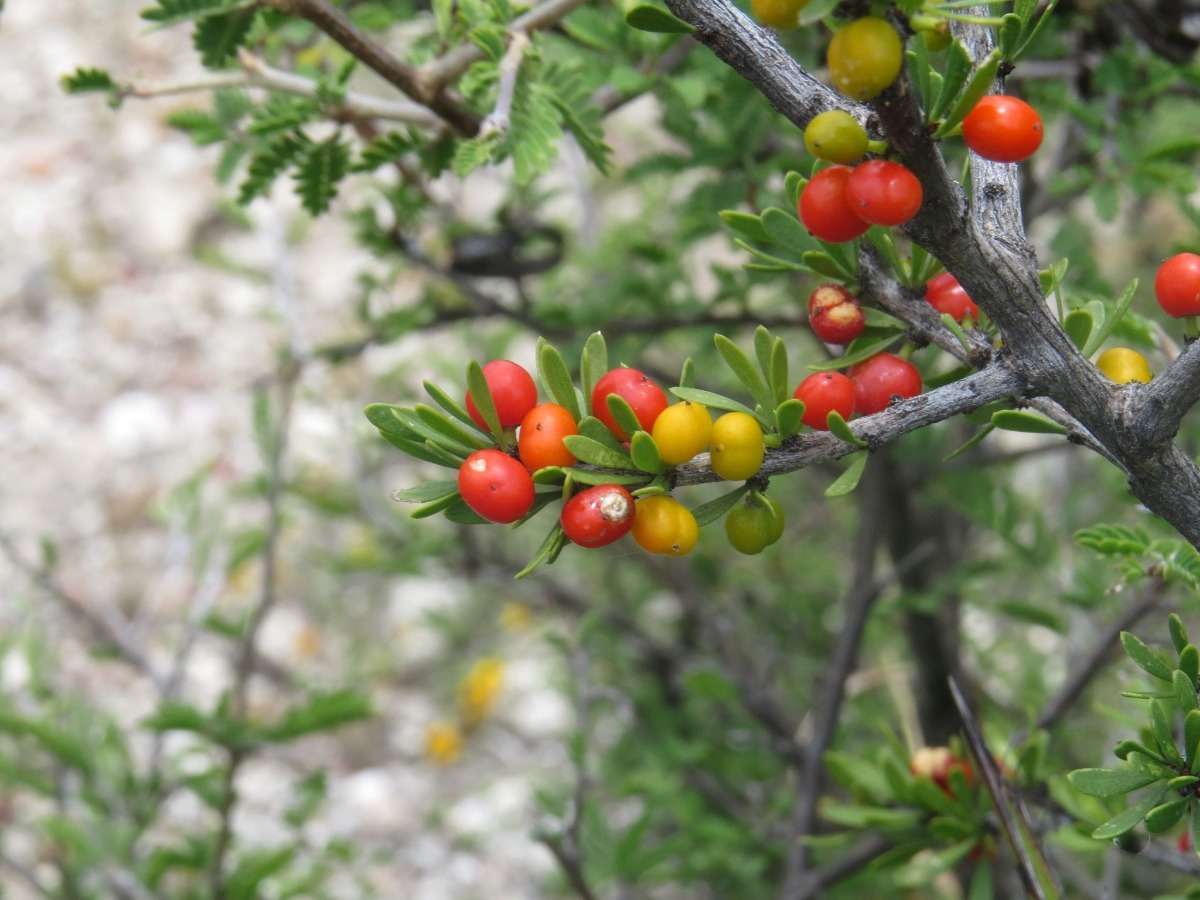Overview
Scientific name: Castela texana
Botanical Family: Simaroubaceae
Common Names: Bitter Chaparro, Bitter Chaparro, Tight Chaparro, Corona de Cristo, Amargosa, Bisbirinda, Bisvirinda, Quasia, Bitter Stick, Dog Grass, Quassia
Common Names in English:
Allthorn castela, Bitter bark, Crown-of thorns, Crucifixion thorn, Goat bush, Holacantha. In Mexico, some of the common names may also refer to other species of the genus Castela, such as C. emoryi, C.retusa, C. polyandra, C. peninsularis, and C. tortuosa, which have similar medicinal properties.
Location: Found in the semi-arid and subtropical regions of Mexico, but also grows in some regions of the southwestern United States.
Parts of the plant used
The branches, leaves and the root.
How is it used?
In Mexico, the branches are cooked in water (decoction) to make a very bitter tasting tea. The decoction can also be applied externally as washing. Also, pieces of the branches can be soaked in water and taken as cold tea, which could be a safer option. Tinctures made with the plant can be taken as drops, but capsules containing the powdered plant can also be taken. Both products are commercially available.
For what do you use it?
In traditional herbal medicine in Mexico, tea made from this shrub has many therapeutic applications, such as the following: Anti-protozoan (including some species of the Entamoeba and Giardia genera), antiviral, astringent, anti-eczema, for gastrointestinal problems, to treat amoebiasis (both oral and gastrointestinal), colitis, diarrhea, dysentery, fever, leukemia, as liver tonic, against malaria, to promote digestion, against stomach cold, to improve appetite and to improve the vision. To treat gallbladder problems, a decoction is made with the root and tea is taken in the morning before breakfast.
Externally, decoction of the branches is applied as a wash or poultice to treat eczema and psoriasis, as well as against skin scratches. Also, tincture made from the branches can be applied as drops on the skin to treat acne .
A methanolic extract obtained from C. texana showed activity against cultured epimastigotes of the parasitic protozoan Trypanosoma cruzi and could be a new source of natural bio-active compounds for the treatment of trypanosomiasis.
Bitter chaparro has been used for several years by traditional Mexican medicine to treat amebiasis and it has been found that this plant is active against the Entomoeba histolytica species. An aqueous extract obtained from the bark of C. texana was evaluated in prokaryotic and eukaryotic cells, in relation to its possible mutagenic, genotoxic and cytotoxic properties. The results showed that the extract showed mutagenic activity when it was evaluated using the Ames test with the TA98, TA100 and TA102 strains of Salmonella typhimuriumn bacteria. Additionally, the plant extract was not genotoxic for DNA synthesis in cultured liver cells, even at the highest concentrations that were tested. The effective antioxidant capacity of the extract could explain its protective effect against pre-cancerous lesions in the liver cells of laboratory rats. The study authors mentioned that more clinical studies are needed to extend their therapeutic use in humans.
Safety / Precautions
The safety of external or internal use of products made from this plant during pregnancy and lactation has not been established. Avoid use during pregnancy and lactation.
If you are currently taking anti-amoeba medications, first check with your healthcare provider before taking this plant, to avoid a possible interaction between the plant and the medicine.
Experiments with laboratory animals have indicated that prolonged consumption may decrease the amount of red blood cells or erythrocytes. It could also cause venous congestion, in addition to chronic tubular nephritis and acute hepatitis.
Tea should not be consumed continuously for more than 20 days, since the active ingredients of the plant could accumulate in the liver.
Avoid ingesting this plant if you currently suffer from liver or kidney disease.
Dose
Tincture [Fresh Plant, 1:2, Dry Plant, 1:5, 50% alcohol] 20-50 drops (as anti-microbial), 5-10 drops (as bitter tonic).
Reference(s)
Chaparro Amaro Compilation by Armando Gonzalez Stuart, PhD
https://www.utep.edu/herbal-safety/hechos-herbarios/hojas-de-datos-a-base-de-hierbas/chaparro-amargoso.html
This article is copyrighted by Ital is Vital, 2025. Want to re-post this article? Visit our guidelines.
DISCLAIMER: THIS WEBSITE DOES NOT PROVIDE MEDICAL ADVICE
The information, including but not limited to, text, graphics, images and other material contained on this website are for informational purposes only. The purpose of this website is to promote broad consumer understanding and knowledge of various health topics. It is not intended to be a substitute for professional medical advice, diagnosis or treatment. Always seek the advice of your physician or other qualified health care provider with any questions you may have regarding a medical condition or treatment and before undertaking a new health care regimen, and never disregard professional medical advice or delay in seeking it because of something you have read on this website.
